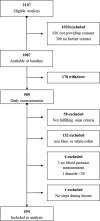Number of steps and systolic blood pressure: Do work and leisure matter?
- PMID: 34181778
- PMCID: PMC9290469
- DOI: 10.1111/sms.14010
Number of steps and systolic blood pressure: Do work and leisure matter?
Abstract
The number of steps per day influences blood pressure and health. However, the association between steps at work and leisure and blood pressure is unknown. Thus, we aimed to investigate the association between the domain-specific number of steps and systolic blood pressure. A thigh-worn accelerometer was used to measure the steps of 694 workers over 1-5 consecutive days, separated into work and leisure domains using a self-reported diary. We linearly regressed steps at work, leisure and total day against systolic blood pressure, adjusting for age, sex, body mass index, smoking, and antihypertensive medication. Additionally, we stratified the analyses on job type (blue-collar or white-collar). The results of this cross-sectional analysis indicated a beneficial association between the number of steps (per 2000-step interval) and systolic blood pressure for the total day (-0.5 mmHg; -1.0 to -0.8, 95% CI, p < 0.05) and work (-0.9 mmHg; -1.5 to -0.4, 95% CI, p < 0.05), but not for leisure (+0.1 mmHg; -0.7 to 0.9, 95% CI, p = 0.75). Blue-collar workers took almost twice as many steps at work (9143 ± SD3837) as white-collar workers (5863 ± SD3565) and, after stratification on job type, we observed a beneficial association between the number of steps at work and systolic blood pressure among blue-collar workers (-1.1 mmHg; -1.7 to -0.4, 95% CI, p < 0.05), but not for white-collar workers (-0.3 mmHg; -1.7 to 1.1, 95% CI, p = 0.7). These findings indicate that the number of steps at work, particularly among blue-collar workers, is beneficially associated with systolic blood pressure. Such findings support the potential of work (re)design to promote walking to improve blood pressure.
Keywords: accelerometer; domain; gait; health; occupation.
© 2021 The Authors. Scandinavian Journal of Medicine & Science In Sports published by John Wiley & Sons Ltd.
Conflict of interest statement
The authors declare that they have no conflicts of interest.
Figures


References
-
- WHO . WHO Guidelines on Physical Activity and Sedentary Behaviour. Geneva: World Health Organisation; 2020. Licence: CC BY‐NC‐SA 3.0 IGO. - PubMed
-
- Morris JN, Hardman AE. Walking to health. Sports Med. 1997;23(5):306‐332. - PubMed
-
- Oja P, Kelly P, Murtagh EM, et al. Effects of frequency, intensity, duration and volume of walking interventions on CVD risk factors: a systematic review and meta‐regression analysis of randomised controlled trials among inactive healthy adults. Br J Sports Med. 2018;52(12):769‐775. - PubMed
MeSH terms
Grants and funding
LinkOut - more resources
Full Text Sources

